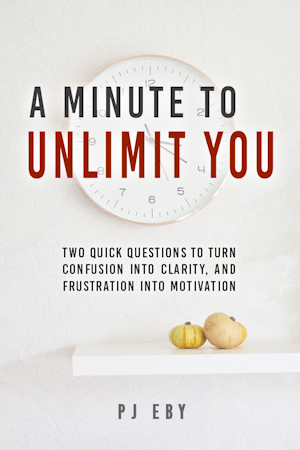Software developers talk about the difference between “hacks” – things they’re playing around with – and “production”, which is the stuff that people actually use and depend on.
Software hacks aren’t often very easy to move into production, and the same is true of mind hacks. For example, one of the first hacks I wrote about here, the trick of finding a lost item, I’ve used very rarely in the months since then. It’s just not a habit.
One of the reasons, of course, is that it’s extremely easy for the conscious mind to interfere, to want to go, “Oh I know where it is” and not actually wait for the subconscious to kick in and do its thing.
But another, and I think more important reason, is that I rarely remember to use it.
In Stretching Your Self I mentioned another mind hack, for reducing the perceived effort of strenuous exercise, a hack I discovered years before I even started this blog. But do you know how many times I’ve used it? Maybe four or five times. Again, I don’t seem to remember to use it.
During the last three or four months, I’ve posted numerous hacks and tricks for increased productivity and greater enjoyment of life. How many times have I used them?
Well, some I’ve used almost daily, but others I only seem to remember when I get stuck hard for a day or two.
Intellectually, of course, I know the techniques exist and that they consistently produce great results. I know I should be visualizing my day before I go to bed the night before. I know I should be using my mind as a time machine to plan and get things done automatically. I know I should be looking into what I’m avoiding.
And on a more mundane level of course, I know I should be exercising more, picking up things and putting them away, eating better, etc., etc., etc.
But this blog isn’t about just adding new things to our lists of what we “should” be doing, increasing our guilt and self-abuse. It’s about finding ways to make things easier.
And that’s what I was thinking about this afternoon, as I was being annoyed by a bunch of clutter on my desk. This morning I had to run out to Circuit City to get a power supply for my computer, because the power supply had died overnight, leaving my PC a dark and silent husk of its former self. So this afternoon there were boxes, receipts, bags, packing material, and manuals on my desk, the old supply was on the floor, tools all over creation, the works.
The Magic of “What if?”
And I said to myself, “Geez, what ever happened to that thing about putting things away as a form of thrill-seeking? I figure these things out and then never use them. Hm. You know, that reverse-time visualization thing made me do certain things automatically. What if I could just run a background task for my subconscious to automatically pick things up and put them away whenever I’m not doing anything else?”
Well, I didn’t say that exactly, it was really just sort of a nonverbal wondering and what-iffing. And as I followed that thought up with a big “Hmmmm…”, I found that my hands were already moving, without me giving any conscious direction. Fascinated, I watched quietly as I cleaned up the place and proceeded to hang some pictures up that I’d been meaning to put up for some time, and also put up the new corkboard and whiteboard I’d gotten last week to put beside my desk. Whenever I went from one part of the house to another to fetch a tool or material, I’d usually be putting other things away at the same time.
The process was fascinating, because there was actually a kind of back-and-forth between my subconscious and me. It would sort of give me requests for executive input when it wasn’t obvious where something should go or how it should work. And sometimes my conscious mind would get involved in something and start to get frustrated, and then my subconscious would point my head or move my hand toward something that provided a more creative way to approach the issue.
For example, I was going to try and use a ruler to measure the spacing of the picture hangers for one picture, and my hand just grabbed the hammer and spaced the hangers using the length of the hammer in each direction from the center point, surprising me with how obvious an idea that was.
But for most of the time, it was just me watching, fascinated, while my conscious mind kept itself busy with speculation about other applications of this technique, and thinking about what I might say in this article.
The funny thing about it is that getting into that mode was so easy. I barely thought to myself how cool it would be, and there it was. It’s pretty much the exact thing I did with all the other mind hacks: I wondered, “what if?”, and “wouldn’t it be cool if?” And lo, there they were.
And so my next thought was, “So why do I always forget about these things? Why does it always take so long to turn them into habits, if in fact I ever do?”
(On a similar note, Leslie and I used to have fights about the same things and reach the same insights about ourselves and our relationship – and then promptly forget about them until it came up again. Sometimes it would take years before we could get an insight to “stick” and consistently put it into action. And some, we’re still working on!)
So, I don’t want to wait for years, I want this stuff to stick now. And it occurred to me that maybe I could use the same hack, as a kind of “meta hack”. For example, what if I visualized myself visualizing? Since I was able to get my subconscious mind to make me walk around and do stuff, surely I could get it to remind me when and what to visualize!
See Yourself Seeing Yourself!
And at that point, my conscious memory popped in to point out that this was in fact an existing NLP technique called “future pacing”. Future pacing in a therapy situation basically means that the therapist gets the patient to see themselves in a variety of future situations, using a technique or new behavior that they’ve just been taught. Because without this step, a lot of changes don’t stick. D’oh!
Before this point, I was putting all of my changes into an old mind frame – new wine in old wineskins, so to speak. Because every time I came up with something new, it was just adding to the list of things that I felt I ought to be doing to make my life better. A new thing to be stressed about, a new thing to feel guilty about!
But now I see it doesn’t have to be that way. All I need to do is get my subconscious to let me know when a technique is applicable. In principle, this means I should be able to turn anything into a “habit” — instantly! – as long as I properly define the cues and responses in my “code”. That is, in my meta-visualizations.
The funny thing about all this – and I mean funny-sad, not funny-haha – is that this whole time I could’ve been getting my subconscious to do all the hard work. Everything I’ve put off, everything I’ve thought I should be doing and wasn’t, I could’ve been riding my subconscious “horse” for, with a corresponding decrease in effort, both physical and mental. Anything that I already know how to do, my subconscious can already do, leaving me free to “supervise”.
And by an interesting coincidence, the book I was looking for when I did my first find the missing book mind hack, was “How To Get Things Done” by David Seabury, written in 1938. And in it, there is a saying: “Don’t work yourself, let your mind do it.” And another: “Use your abilities; don’t work yourself!”
And in the process of looking up those phrases just now to make sure I got them right in this article, I saw a whole bunch of other stuff that relates. This Seabury cat really sounds like he knew how to do exactly the things I’m experimenting with now.
Of course, before I knew that this was such a literal phenomenon, I never really understood what it was he was getting at! Now that I do, it should be quite interesting to re-read. I’ll let you know what comes of that.
In the meantime, I’m going to experiment with future-pacing the various hacks I’ve discovered, and practicing getting my subconscious mind to start tasks for me. For that matter, I’m really curious to find out what I can accomplish with “background tasks”, like my new “put things away whenever I’m not too busy” thread. It’ll be especially interesting to find out whether it is really possible to create and “install” new habits this simply, using the principles of in-body visualization (i.e., “command mode”).
(P.S. Notice again the difference between knowing and doing: I’ve read a zillion NLP books and articles that mention future pacing – but I don’t think I’ve ever actually done it on purpose before!)








Seems involved. Perhaps it would be easier all round to move RuleDispatch into beta instead:).
I’ve never done any NLP research, but I guess it’s time to at least look into the ‘future pacing.’ I also like the concept of ‘background tasks.’ I’m sure we have lots of unused bandwidth in the backs of our minds that could be used more productively.
My current method for wedging stuff into my conscious mind is to use memotome.com to send myself emails on a regular or irregular schedule. Putting one of your post’s URLs into a memo and sending it to me regularly so that i can reread it, or printing it out and putting it in my tickler file.
But as you say, that’s shoving another book into the pile instead of rearranging the pile.
I’ll have to re-read this post again — or maybe, since I’m working on a big project today doing something I’ve never done before, just ask my subconscious to ‘please handle this’ and step aside and see what happens.
Thanks again for another stimulating post.
Most of your other posts I have just read and appreciated, meaning to spend the time to do as you do, that is to try and apply the things you mention. But this one, the description you gave about how you communicated with your subconscious and it just kicked into auto-drive, it sounds like what I have been experiencing for the last week.
Unfortunately where you apply yourself and get a result, I think my lack of application had it happen by accident for me.
I had a massive stack of dishes on the bench, and it had been there for over a month. Now, I have always hated washing dishes, and I did not see myself doing them any time soon. However, I happened to read some article on reddit.com about how some housewives are more organised than others and what the more organised ones do differently, and it just clicked.
I guess my subconscious got the message. Whereas before, I would leave everything that needed to be done and just do it when I found the time. Now my subconscious just kicks into overdrive and does stuff at the soonest opportunity. It is quite a remarkable feeling to find yourself doing things that you disliked before and now enjoying the sensation of just flowing through it.
One of the thing I’ve learned from Kung Fu is that practice leads to perfection. At first, you’ll be struggling to get all things correct, the base and the kick, and then balance yourself not to fall. And you do it many times: then, at least, you’ll be doing the kicks without woring, because everything is perfect. You can, then, focus on your task ahead (beating your oponent, or doing the next move of the kati, or whatever).
The first period is the time for learning (the “hack” time), and the second is the time when you acctually use the moves you learned all the time (the “production” time). It’s just another point of view on the issue, maybe helps, maybe not.